The most attractive employers in Hungary in 2024

For the 11th time, the most attractive employers in Hungary were honoured with the Randstad Award.
According to Hungarian employees, LEGO is the most attractive employer in Hungary this year, BT (British Telecommunications) came second and Mercedes-Benz came third. The Randstad Employer Brand survey also reveals, among other things, the extent to which employees are considering changing jobs, the criteria they use to choose a new job, the sectors they find most attractive, and whether they are willing to be mobile at home or would prefer to work abroad.
Where would Hungarians prefer to work?
On 25 April 2024, the winners of the Randstad Award for Hungary were announced at a gala event in the Várkert Bazaar. LEGO was named the most attractive employer, while BT and Mercedes-Benz defended their second and third place positions from last year.
Libri, the Hungarian National Bank, MOL, Novartis, Accent Hotels, Coca-Cola, Szerencsejáték Zrt., Magyar Telekom, Wizz Air, Lufthansa Systems and KÉSZ Group won special awards in their respective sectors. The best known employer was Aldi.
What do Hungarian workers want most?
According to recent Employer Brand research by Randstad, attractive wages and benefits packages will remain the top priority for Hungarian employees in 2024 in terms of job choice preferences. They also put a high value on a pleasant work atmosphere, how they experience everyday life in the workplace environment, and how they relate to their colleagues and managers. The financial stability of the employer, where the job is long term, where there is no fear of redundancy and where there is the possibility of achieving a work-life balance, is also a major factor – the value of the latter has increased compared to two years ago.
Compared to last year, the top preferences of Hungarian workers and even their ranking remained the same, however, the survey also showed that the importance of these aspects is significantly higher among Hungarian workers compared to the European average. In particular, there is a striking difference in the degree of expectation for an attractive salary and benefits package, a pleasant working atmosphere and the financial stability of the employer.
“Unfortunately, all this shows that these motivators are still not self-evident in our country, and employees have to constantly reiterate what they want when setting their expectations,” said Sándor Baja, Managing Director of Randstad.
While chasing the top 3 motivators, much less attention is paid to the job content itself, its interesting nature or even the general perception of the company. On average in Europe, these are much more important expectations.
Different needs by gender and education level
The top 5 driving factors for choosing a job are the same for both sexes, but for reasons that go back to our social context, some attributes show significant differences between the expectations of women and men. Convenience and accessibility of the workplace and the possibility to remote work/home office are more important for women than for men, and equality of opportunities is also a priority for women.
Although the first 5 factors show the same results in terms of educational attainment, there are striking differences in the order of preference and even differences in other drivers. For those with primary education, a pleasant working atmosphere is a much more important factor than pay, and they value a comfortable approach to the workplace or equal opportunities more than those with secondary or higher education.
The data show that those with a secondary education are the most concerned about their income: for them, salary and long-term job security are more important than for others. For those with a higher level of education, in addition to top factors, comfort and quality are also important. They are more interested in the possibility of remote working/home office, the interesting nature of the job, the use of modern technologies or the quality of the product offered by the company.
Expectations vs. reality
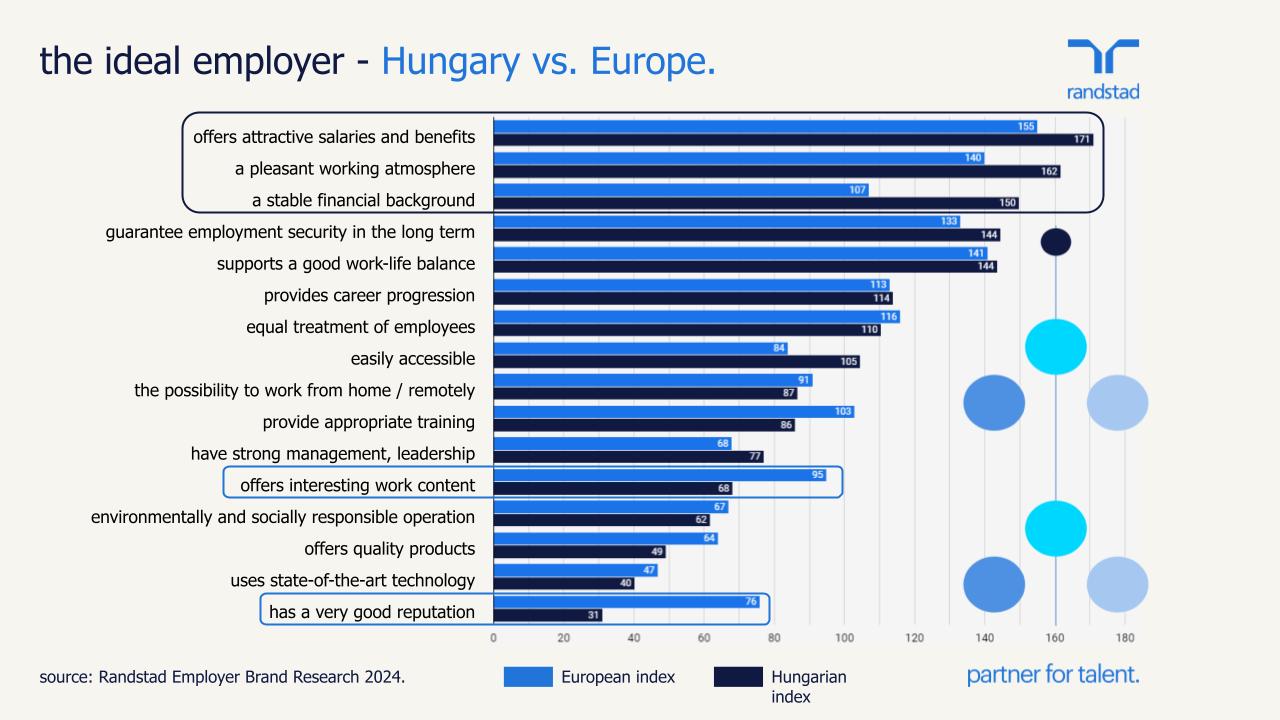
When respondents were asked to describe their current employer in terms of the values that are important to them, there were also significant differences between experience and expectations, i.e. employees do not get what they generally consider important or what they want in their daily lives.
According to the responses, what workers value most in their current jobs is that they have a good location and job security. Salary, the most important aspect for them, is only ranked ninth on the list of good things about the company.
There is also room for improvement for employers in terms of a pleasant working atmosphere, which is the second most important characteristic that employees consider to be ideal for their workplace, but is only ranked fourth among the values offered by their current employer.
For employers, a deeper understanding of this, bridging the gap between aspirations and reality, is an opportunity on a silver plate to build a more engaging employer brand by developing a more attractive value proposition.
Not all sectors are equally attractive
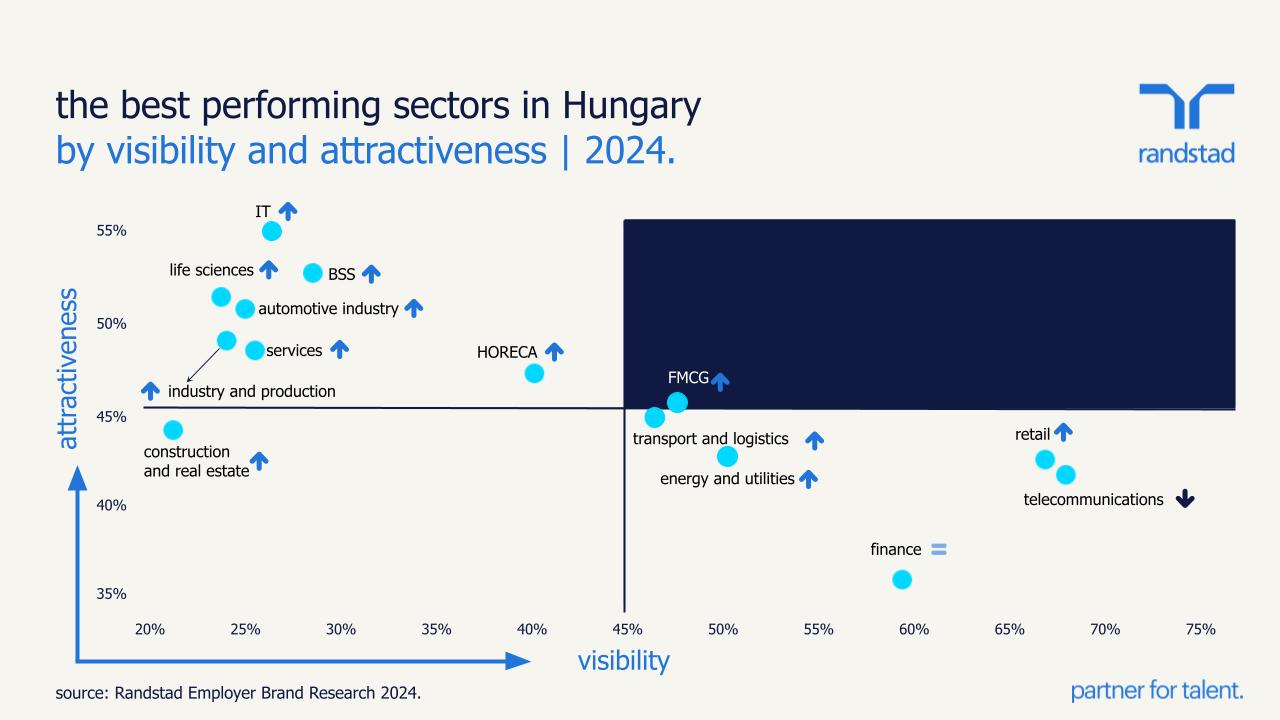
The IT sector remains the most attractive sector in Hungary, despite its recent downturn. It is closely followed by the BSS (business services sector) in second place, while life sciences and automotive companies have moved up to third place on the imaginary podium. The difference in attractiveness between the sectors is quite small, so employers are not only competing for talent within their own sector, but also have to compete with other sectors.
Almost all sectors, to varying degrees, have been able to improve their attractiveness compared to last year. The attractiveness of the BSS, automotive, manufacturing and HORECA sectors has increased spectacularly, while the telecoms sector has declined significantly and companies in the financial sector have stagnated in this respect. Attractiveness is not everything, however: the overall visibility of the sectors considered most attractive is well below average. In this respect, employers with a more widely known consumer brand, such as retail, telecoms or financial services, are in a much better position.
Money, money, money
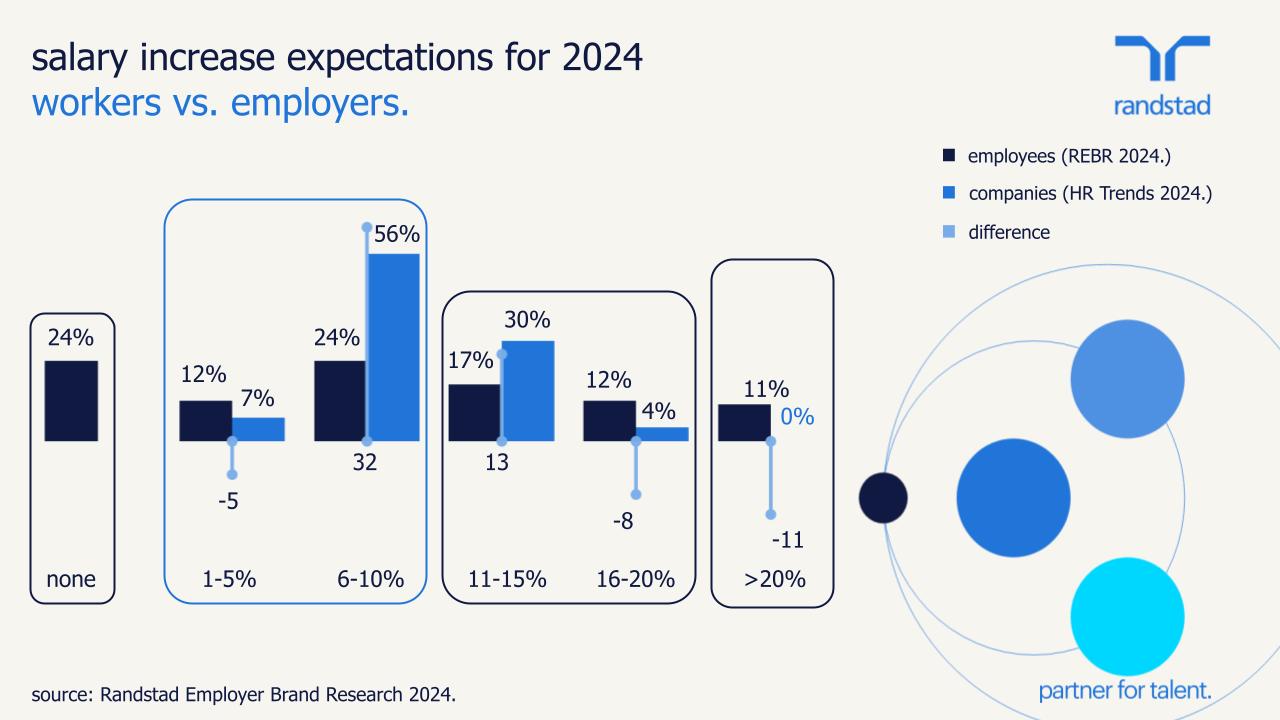
The pace of pay rises is key, especially after years of Europe-beating inflation.
According to research by Randstad HR Trends Survey, published earlier this year, almost all of the surveyed companies reported that they had implemented pay rises in 2023 – and some of them more than originally planned.
Despite this, just under eight in ten (12%) of Randstad Employer Brand Research respondents feel that their employer has fully compensated them for the effects of inflation, with a third (34%) saying that their pay rise has only partially offset the increased costs of inflation. And nearly a third (29%) have not received any support from their employer. Workers who received no compensation are almost twice as likely to quit (41%) than those who received some form of support (23%).
The Randstad Employer Brand survey also asked employees in January this year how much they expect their wages to increase in 2024. Almost one in four workers were so pessimistic about the situation that they did not expect a pay rise. More than a third of respondents expected an increase of between 1-10%, the rest predicted more. But the HR Trends survey published earlier this year showed that nearly two-thirds of employers plan to raise wages between 1-10%. So those who expected more were disappointed.
Turnover levels stabilising
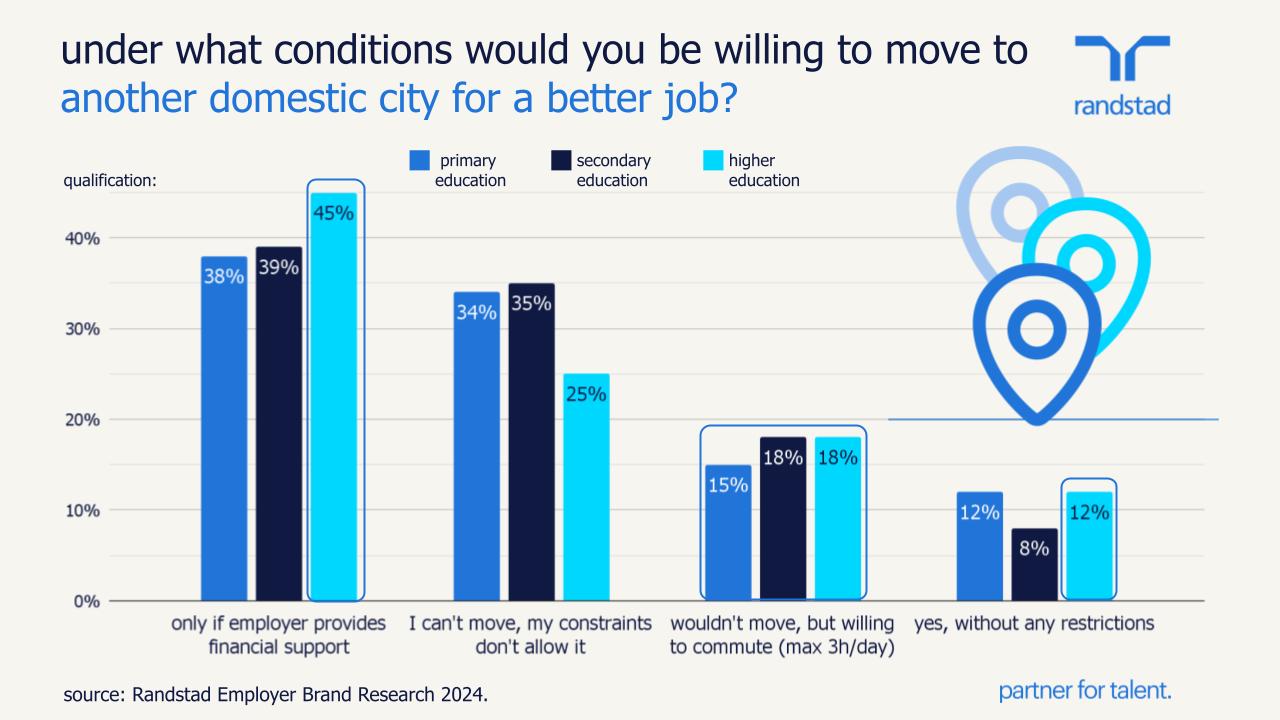
The willingness to change jobs has not changed significantly compared to last year and appears to be stabilising. At the beginning of 2024, 15% of survey respondents said they had changed jobs in the 6 months prior to the survey and 30% plan to change in the next six months. These figures are similar to last year’s results (when 14% had changed and 29% planned to change). This shows that only half of the dissatisfied have actually changed jobs.
The research showed that in the second half of 2023, the percentage of people changing jobs was similar for men and women, but within the organisation, men were more likely to change jobs than women (men: 14.2%, women: 8%).
“A higher percentage of men switching positions within an organisation can mean a lot of things. It can reinforce the general perception that men have better opportunities for promotion in our country, but also that a higher proportion of them find opportunities for horizontal movement,” says Sándor Baja.
It is also clear from the research that the younger the generation of workers, the more likely they are to change employers: nearly 20% of 18-24 year olds will have changed employers in the second half of 2023, compared to only 9% of 55-64 year olds.
“In a labour shortage environment in our country, the loyalty of the older generation is a real asset, and it is worth making better use of the opportunities in this segment, giving them the chance to develop and train.”
In terms of educational level, the strongest desire to change employer is among those with a primary education: more than a third of respondents in this group would like to change employer. Nearly a third of those with secondary education would also like to change, but very few (7%) can imagine a change or promotion within the company.
Mobility: even open to going abroad
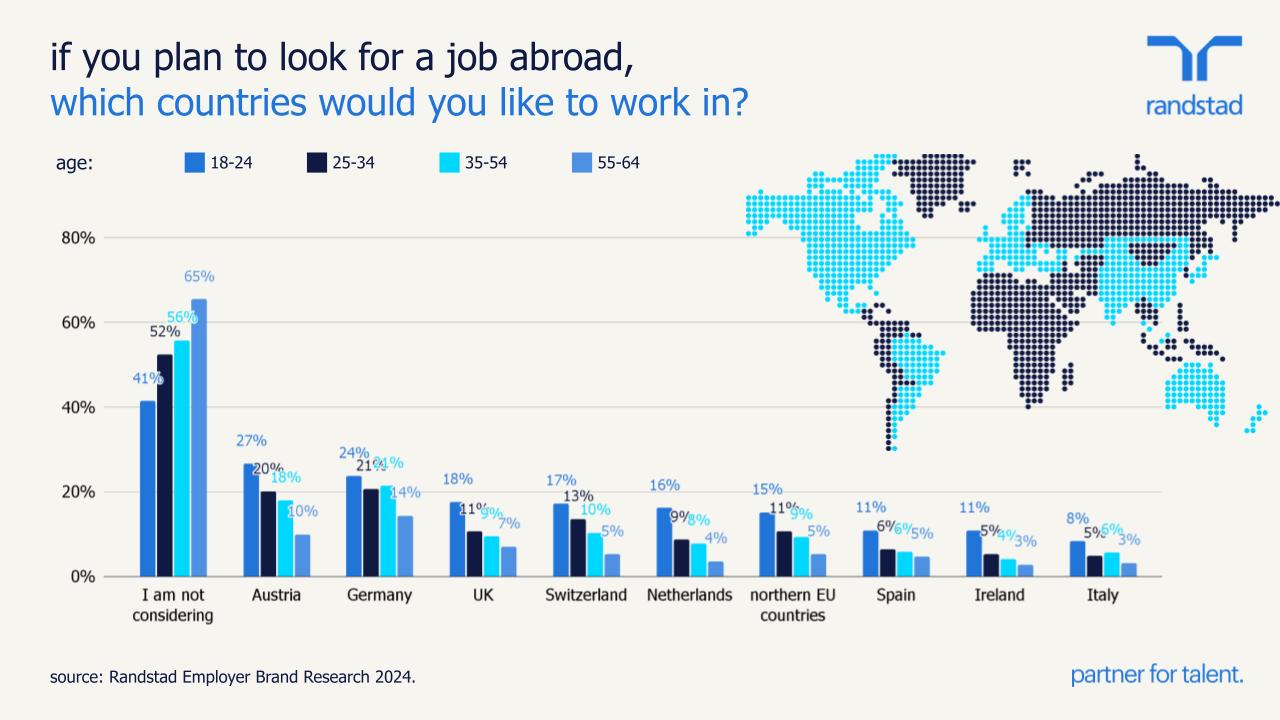
Most of the new investment in our country targets less developed rural locations with fewer job opportunities. Besides labour from third countries to fill jobs, the issue of internal mobility is often raised. Hungarians are generally perceived as being more reluctant to move, and most people consider a commuting distance of 1 hour per direction when assessing the potential workforce.
However, the Employer Brand research shows that we are not so tied when the hope of a better job arises. More than half of the higher education graduates surveyed are willing to move within the country for a better job opportunity: 12% unconditionally and 45% if their employer provides financial support for the relocation. Almost the same is true for those with a primary education (12.5% and 37.7% respectively). Those with a secondary education are slightly less mobile.
Moreover, the results on willingness to commute are also surprising: up to 3 hours of travel per day is affordable for almost 18% of those with intermediate and higher education, but also for 15.3% of those with primary education.
Hungarian workers are not only mobile within the country: the vast majority of 18-24 year olds (59%) are open to work abroad. They prefer to work in physically closer Western locations, such as Germany, Austria, Switzerland, the Netherlands or the United Kingdom, which are easily accessible by car and public transport. Almost half of 25-54 year-olds and, surprisingly, a third of 55-64 year-olds would consider working west of us.
Those with a primary education are the most interested in working abroad, with 53% considering it, but 48.6% of those with a higher education and 42.4% of those with a secondary education would also consider moving for a better job.
The importance of training and re-skilling
Maintaining employability, continuous training and the possibility to work with higher added value are key issues today.
It is mainly workers with higher education qualifications who are the most supported by employers in terms of training opportunities (60%). It is quite an imbalance that only 42% of workers with secondary education are offered this form of development. Their answers to the various questions reveal a certain stagnation, and their continuing training will therefore be crucial for the future.
However, it is not only this group that needs training: at all levels of qualification and in all age groups, over 50% of those who consider training to be essential for their career development
“Although it varies by demographic group, development opportunities also shape the perception of employers. We would like to believe that providing this can also help people stay in the country,” said Sándor Baja.
The top 3 most attractive employers in Hungary in 2024 according to Randstad Employer Brand Research
- LEGO
- BT (British Telecommunications)
- Mercedes-Benz
Special awards by sector
- Most Recognised Employer: Aldi
- Most attractive employer – Energy and Utilities category: MOL
- Most attractive employer – Life Sciences category: Novartis
- Most attractive employer – HORECA category: Accent Hotels
- Most attractive employer – FMCG category: Coca-Cola
- Most attractive employer – Telecom category: Magyar Telekom
- Most attractive employer – Transport & Logistics category: Wizz Air
- Most attractive employer – IT category: Lufthansa Systems
- Most attractive employer – Construction and Real Estate category: KÉSZ Group
Randstad Employer Brand Research
Randstad Employer Brand Research is the most comprehensive, in-depth independent employer brand research in the world, selecting the most attractive employers from thousands of companies. The research gathers the opinions of nearly 173,000 respondents aged 18-64 from 6084 companies in 32 markets.
In Hungary, 7568 people took part in the survey. The analysis provides insights into the job preferences and motivations of potential employees.
The research, conducted since 2000, was carried out by Randstad’s international research partner Kantar. The current survey was conducted in January 2024. The survey results are the basis for the annual Randstad Awards for the most attractive employers.
Read also:
- Unforeseen: Hungarian guest workers are leaving Austria – here is why
- Shocking: Romanians now live better than Hungarians? – UPDATE
Featured image: depositphotos.com
Source:





